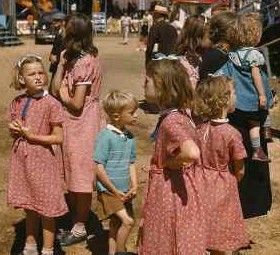WHEN DRESSES MADE FROM BAGS WERE EN VOGUE

 A good many summer vacations in my childhood were spent on my grandparents’ farm in northwest Missouri. It was the 1960s and the older people still “went visiting.” Grandma took me in tow when she made her weekly rounds calling on fellow rural ladies of a certain age.
A good many summer vacations in my childhood were spent on my grandparents’ farm in northwest Missouri. It was the 1960s and the older people still “went visiting.” Grandma took me in tow when she made her weekly rounds calling on fellow rural ladies of a certain age.
Most farmhouses had an old pedal Singer sewing machine tucked in a corner somewhere. They’d been purchased when Woodrow Wilson was president and had seen continual use ever since. As we were leaving one particular matron’s home (departures were long, drawn out affairs back then, sometimes lasting a good half an hour) Grandma and our hostess got to talking about it. The old lady gently patted the cast iron relic and proudly said, “Mama sewed our flour sack dresses on this.”
 Once inside Grandma’s old Chevy sedan it was finally safe for me to speak (because children were expected to be quiet when visiting company). I asked, “What was a flour sack dress?” That was a new one to me. So Grandma filled the return trip with the Greatest Generation’s favorite pastime: recollecting the suffering they had endured during the Great Depression.
Once inside Grandma’s old Chevy sedan it was finally safe for me to speak (because children were expected to be quiet when visiting company). I asked, “What was a flour sack dress?” That was a new one to me. So Grandma filled the return trip with the Greatest Generation’s favorite pastime: recollecting the suffering they had endured during the Great Depression.
It’s easy for those of us who came later to roll our eyes in bemusement. Yet that experience had deeply scarred those who had gone through it. Their survival was a testimony to their toughness.
 Grandma took me back to the early 1930s. Everybody was in the same boat, she said. The whole country was flat broke. There simply was no work to be had. That meant no money. Their motto became became, “Make it yourself, make do, or go without.”
Grandma took me back to the early 1930s. Everybody was in the same boat, she said. The whole country was flat broke. There simply was no work to be had. That meant no money. Their motto became became, “Make it yourself, make do, or go without.”
Money or not, daily needs still had to be met. Such as clothing your family. That was especially challenging for large farm families with many children. Desperate times call for desperate measures, they say. And desperate mothers took matters into their own hands. They made dresses out of the only thing that was handy.
In that time before eating out wives cooked at home. They also purchased far fewer items at the grocery than they do today. Why buy bread, biscuits and pie crusts when you could bake your own? So they bought flour in giant 50 and 100 pound bags. Those sacks were made of durable cotton woven so sturdy the contents didn’t seep out. If that was good enough for flour, farm wives said, it was good enough for clothing.
 So they cut up empty flour sacks and turned them into dresses. As one woman remembered years later, “The first time I wore one to school I felt self-conscious about it. But then I noticed most of the other girls were wearing them, too. That was the last I thought about it.”
So they cut up empty flour sacks and turned them into dresses. As one woman remembered years later, “The first time I wore one to school I felt self-conscious about it. But then I noticed most of the other girls were wearing them, too. That was the last I thought about it.”
The practice became so widespread, one historian estimated as many as 3.5 million mothers and daughters wore homemade flour sack dresses during the Depression. That wasn’t lost on the big mills that produced and sold flour.
 Many began putting their product in cotton sacks decorated with brightly colored floral prints. They even made labels with ink that came off with a good washing. Soon, flour bags stacked in groceries resembled bolts of cloth in dry goods stores.
Many began putting their product in cotton sacks decorated with brightly colored floral prints. They even made labels with ink that came off with a good washing. Soon, flour bags stacked in groceries resembled bolts of cloth in dry goods stores.
America eventually clawed its way back to prosperity. In the economic boom that followed World War II, flour sack dresses were quickly discarded as unwanted reminders of the hardships people had endured. Years later they resurfaced in the memory of old folks, transformed from symbols of shame into badges of honor. Those homemade dresses exemplified the toughness of people determined to survive the hardest of hard times.
 Resilience is a key component of the American Spirit. I pray we never face the test of character our ancestors confronted eight decades earlier. But if we do, I hope there’s a good supply of flour sacks on hand to help us get through it.
Resilience is a key component of the American Spirit. I pray we never face the test of character our ancestors confronted eight decades earlier. But if we do, I hope there’s a good supply of flour sacks on hand to help us get through it.
Did you find this enjoyable? Please continue to join me each week, and I invite you to read Tell it Like Tupper and share your review!
Curious about Tell It Like Tupper? Here’s a chance to see for yourself. Take a sneak peek at a couple chapters in this free downloadable excerpt.

The way I learned it:
Use it up.
Wear it out.
Make it do.
Do without.
I’ve heard that variation, too, Walter. Thanks for sharing!
We have a hand made quilt that my grandmother-in-law made out of flour sacks. Resourceful and amazing.
Great story, thanks for sharing!